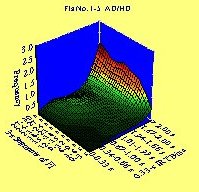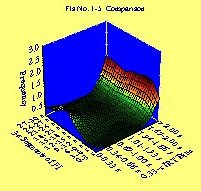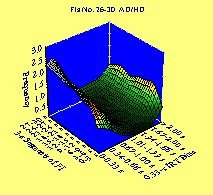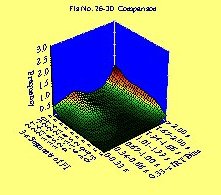Invited Symposium: What Can Genetic Models Tell Us About Attention-Deficit Hyperactivity Disorder (ADHD)?
| INABIS '98 Home Page | Your Session | Symposia & Poster Sessions | Plenary Sessions | Exhibitors' Foyer | Personal Itinerary | New Search |
Results
Sergeant and coworkers [35] have debated the role of attention in AD/HD even though these children tend to behave inattentively. It seems that perceptual processes are not altered in AD/HD [36]. The attention problems of AD/HD children are typically described as 'distractibility' and trouble with 'sustaining attention' [37]. In the clinics, the problems with sustained attention occur only in situations where stimuli are widely spaced in time [38] or when the ability to concentrate is stressed by the task being unwelcome or uninteresting [1].
Behavior during the (signaled) extinction component, when no reinforcer was ever given, measured sustained attention. The AD/HD children (as well as the SHR) did not differ from comparison children at the start of testing. The sustained attention deficit in the extinction component developed as gradually by time. Both AD/HD and comparison children noticed when the light signaled that the schedule changed to the extinction component by ceasing to respond, but the AD/HD children resumed responding after a short time (Fig. 2).
 Fig. 2: Mean number of responses as a function of group (ADHD vs. comparison), extinction (EXT) number, and 24-s segment of the 2-min EXT component. (Modified after [34]).
Fig. 2: Mean number of responses as a function of group (ADHD vs. comparison), extinction (EXT) number, and 24-s segment of the 2-min EXT component. (Modified after [34]).Closely similar results were obtained with SHR. These studies indicate normal sensitivities to stimulus change, but a deficient sustained attention in AD/HD and SHR (Fig. 3).
 Fig. 3: Mean number of lever presses by each group during the 5-min extinction (EXT) component as a function of 1-min segment of the EXT period. (Based upon [5; 12; 19; 21]).
Fig. 3: Mean number of lever presses by each group during the 5-min extinction (EXT) component as a function of 1-min segment of the EXT period. (Based upon [5; 12; 19; 21]).
Overactivity
AD/HD children show restlessness, fidgeting and generally unnecessary gross body movements [1; 39]. The overactivity might not always be present [1] as it seems to be absent in novel situations [34; 40]. When tested with the multiple fixed-interval/extinction schedule of reinforcement, the AD/HD children had the same activity level as the comparison children at the start of testing. The overactivity in the fixed-interval component developed as gradually more reinforcers were given (Fig. 4).
 Fig. 4: Mean number of responses as a function of group (ADHD vs. comparison), fixed interval (FI) number, and 3-s segment of the 30 s FI. (Modified after [34]).
Fig. 4: Mean number of responses as a function of group (ADHD vs. comparison), fixed interval (FI) number, and 3-s segment of the 30 s FI. (Modified after [34]).
Closely similar results were obtained with the SHR. Thus, the WK-HA strain is hyperactive in open fields [19], but evidently not when an the behavior is under the control of an operant reinforcement schedule. The group treated with PCB 153 [5] is the only other group showing an overactivity similar to that of the SHR (Fig. 5).
 Fig. 5: Mean number of lever presses by each group during the 2-min fixed-interval (FI) component as a function of 10-s segments of the FI. (Based upon [5; 12; 19; 21]).
Fig. 5: Mean number of lever presses by each group during the 2-min fixed-interval (FI) component as a function of 10-s segments of the FI. (Based upon [5; 12; 19; 21]).
Motor impulsiveness
Impulsiveness is increasingly seen as the symptom of greatest significance [1; 41]. The peculiar AD/HD style of brief, short sequences of activity on tasks and rapid change is typical in the SHR [19; 22].
With the multiple fixed-interval/extinction schedule, motor impulsiveness was operationalized as bursts of responses with short interresponse times. The AD/HD children did not show any motor impulsiveness at the start of testing. The impulsiveness developed gradually (Fig. 6).



 Fig. 6: Three-dimensional plots of the mean responding during the initial five 30-s fixed intervals, FI numbers 1-5, and final five 30-s fixed intervals, FI numbers 26-30 of the AD/HD and comparison group. The group mean frequencies of responses are shown as functions of 3-s segments of the fixed interval and interresponse time (IRT bins). Responses occurring during the initial 3 s after the reinforcer was delivered were accumulated in the first 3-s segment, responses occurring between 3 and 6 s after the delivery of the reinforcer were accumulated in the second 3-s segment, etc. Similarly, a response emitted less than 0.33 s after the previous response was accumulated in the 0-0.33 s IRT bin, a response emitted more than 0.33 s, but less than 0.67 s after the previous response was accumulated in the 0.34-0.66 s bin, etc. The most distant corner shows the mean sum of responses with IRT > 2 s occurring during the last 3 s of the five 30-s fixed intervals. (Modified after [34]).
Fig. 6: Three-dimensional plots of the mean responding during the initial five 30-s fixed intervals, FI numbers 1-5, and final five 30-s fixed intervals, FI numbers 26-30 of the AD/HD and comparison group. The group mean frequencies of responses are shown as functions of 3-s segments of the fixed interval and interresponse time (IRT bins). Responses occurring during the initial 3 s after the reinforcer was delivered were accumulated in the first 3-s segment, responses occurring between 3 and 6 s after the delivery of the reinforcer were accumulated in the second 3-s segment, etc. Similarly, a response emitted less than 0.33 s after the previous response was accumulated in the 0-0.33 s IRT bin, a response emitted more than 0.33 s, but less than 0.67 s after the previous response was accumulated in the 0.34-0.66 s bin, etc. The most distant corner shows the mean sum of responses with IRT > 2 s occurring during the last 3 s of the five 30-s fixed intervals. (Modified after [34]).
Motor impulsiveness is seen in male SHR. Neither female SHR, male WK-HA, nor any of the other untreated strains showed motor impulsiveness. Male Lewis rats treated with PCB 153 is the only other group showing an impulsiveness similar to that of male SHR (Fig. 7).
 Fig. 7: Three-dimensional plot of the terminal SHR responding during the 2-min fixed-interval component of the schedule of water reinforcement. The group mean numbers of responses (y-axes) are shown as functions of 10-s segment of the fixed interval (x-axes) and interresponse time (IRT bins; z-axes).
Fig. 7: Three-dimensional plot of the terminal SHR responding during the 2-min fixed-interval component of the schedule of water reinforcement. The group mean numbers of responses (y-axes) are shown as functions of 10-s segment of the fixed interval (x-axes) and interresponse time (IRT bins; z-axes).
Cognitive impulsiveness
AD/HD children have problems with cognitive impulsiveness as well as motor impulsiveness. Evenden [42] has performed a series of studies of SHR (cognitive) impulsiveness. In a task where the animal is required to press a certain number of times on one lever before changing to a single press on the other lever in order to obtain the reinforcer, it was shown that SHR, but not control WKY, had great difficulties with pressing more than 6-7 times on the first lever before changing to the other.
Other behavioral similarities
AD/HD behavior is generally more variable than what is normal [43; 44]. Also SHR shows increased behavioral variability [16]. Finally, the deficient response re-engagement in AD/HD children [43] is similar to the deficient response re-engagement seen in SHR when high response rates are induced by the reinforcement schedule [45].
Conclusion on the face validity of the SHR as an animal model of AD/HD
It is obvious from the results of studies that have been using the same behavioral schedule for testing AD/HD children and various rat strains, that male SHR is the only strain showing all the behavioral characteristics of AD/HD as operationalized: A sustained attention deficit without obvious sensory problems, a normal activity level in a novel situation that develops into overactivity after some time, and motor impulsiveness that is not present in a novel situation but develops and is a major component of the overactivity. Finally, just like AD/HD children, the male SHR shows cognitive impulsiveness, increased behavioral variability and a deficient response re-engagement. Thus, it seems reasonable to conclude on the basis of the present evidence that face validity of the SHR as an animal model of AD/HD has been confirmed since it mimics the fundamentals of the behavioral symptoms of AD/HD.
Construct validity - does changes in SHR genetics, neurobiology and behavior conform with a theoretical rationale for AD/HD?
It is increasingly clear that AD/HD is associated with altered dopamine function. Dopamine gene polymorphism has been shown in AD/HD [46-48]. It is therefore interesting that altered dopamine functioning has been shown in the SHR too [49-53]. One may predict that dopamine hypofunctioning results in altered reinforcement processes in AD/HD since dopamine release in the nucleus accumbens is associated with reinforcement [54]. Altered reinforcement processes as one factor in AD/HD symptomatology have been suggested repeatedly [34; 37; 55-59].
Altered Effects of Reinforcers
Under some schedules of reinforcement, it has been shown that differences between SHR and WKY behavior are solely due to a changed reactivity to reinforcers and not to any higher maximal response rate in the SHR [20; 45]. Reinforcers act retroactively on responses that already took place and changes the probability of future responding [60]. The reinforcing effect is largest when the reinforcer is delivered immediately after the occurrence of the response and wanes as a function of the delay of the delivery of the reinforcer. This relation between the effect of the reinforcer and the time interval between response and reinforcer is commonly known as the "delay-of-reinforcement gradient" or simply as the "delay gradient" [34; 60] (Fig. 8).
 Fig. 8: Theoretical delay-of-reinforcement ("reward") gradients. The effect of a reinforcer is more potent when there is a short delay between the response and the reinforcer than when there is a longer delay. The delay gradient may be steeper in the ADHD children than in normal children. (Modified after [34].
Fig. 8: Theoretical delay-of-reinforcement ("reward") gradients. The effect of a reinforcer is more potent when there is a short delay between the response and the reinforcer than when there is a longer delay. The delay gradient may be steeper in the ADHD children than in normal children. (Modified after [34].
Further, a reinforcer acts not only on the response that produces it, but also, to a lesser degree, on responses emitted earlier [61]. It will be argued that at least partially, all three symptoms of AD/HD as well as the behavior of the SHR, deficient sustained attention, overactivity and impulsiveness, may all be due to one factor: a shorter delay-of-reinforcement gradient. This may explain why these three symptoms sometimes emerge as one factor in factor analyses (see [1]).
Overactivity. Children with AD/HD and the SHR might have a steeper and shorter delay gradient [34; 41; 56; 57]. A reinforcer in close proximity to a response may therefore be more effective in AD/HD children and in SHR than in controls. This will generate overactivity as gradually more reinforcers act on the behavior taking place in a particular situation.
Increased behavioral variability. AD/HD and SHR behavior is generally more variable than what is normal [16; 43; 44]. Variability is adaptive in some situations and acts as an operant response that may be modified by reinforcers [16; 62]. Thus, it is not surprising that there are systematic differences in the behavioral problems of AD/HD depending on the type of situation [1]. The increased variability may be explained as an altered delay-of-reinforcement gradient: the behavior that frequently is reinforced in AD/HD (and in SHR) is the behavior that randomly occurs immediately before a reinforcer is delivered. A more effective immediate reinforcer in AD/HD and in SHR will have a greater impact and therefore increases the likelihood also of the randomly occurring behavior, not only the systematically occurring normal behavior.
Motor impulsiveness. Not only single responses, but also relations between responses (e.g., interresponse times, IRTs) are conditioned and maintained by reinforcers [34; 41; 60; 61]. In contrast to the normal delay gradient, only short IRTs may be reinforced and maintained by a short delay gradient (Fig. 8). This explains why motor impulsiveness, responses emitted with short interresponse times, is not present in a novel situation, but develops gradually as more reinforcers modify the behavior of AD/HD and SHR [12; 34; 41].
Analyses of activity level as functions of reinforcement densities [45] showed no difference between hyperactives and controls when the reinforcers were frequent, only when they were infrequent. The reason for this is that frequent reinforcers will reinforce responses with short interresponse times only, produce motor impulsiveness and therefore make normal behavior more AD/HD like. Further, the density of reinforcement may be critical whenever SHR behavior deviates from normal. Thus, motor impulsiveness may due to altered reactivity to reinforcers and not vice versa (cf., Taylor [1]).
Impaired sustained attention. Since a reinforcer acts not only on response occurring immediately prior to its delivery, but also on responses emitted earlier, all responses occurring between the delivery of two consecutive reinforcers will usually be reinforced in normal children. Since the delay gradient may be steeper and shorter for AD/HD children than for normal children, relatively fewer of the correct responses are reinforced in AD/HD than in normal children simply because the delay gradient is too short to affect all responses occurring in the time interval between two reinforcers. This results in poor stimulus control and possibly impaired 'sustained attention' in AD/HD as well as in the SHR [12; 34; 63].
Conclusion on the construct validity of the SHR as an animal model of AD/HD
It might be premature to conclude on the construct validity of SHR as an animal model of AD/HD since there is only limited agreement on the theoretical rationale for AD/HD, but a promising hypothesis is the one suggesting altered dopamine function as a key factor in AD/HD (for a review see [41]). A hypofunctioning meso-limbic dopamine system producing a shorter delay-of-reinforcement gradient, a hypofunctioning meso-cortical dopamine system producing cognitive impulsiveness, and a hypofunctioning nigro-striatal dopamine system causing several "extrapyramidal" symptoms associated with AD/HD.
Predictive validity - predicting aspects of AD/HD genetics, neurobiology and behavior previously unknown
Although several authors [37; 37; 55; 57-59] have argued that altered reinforcement processes are important in AD/HD symptomatology, details of these processes and their consequences were not known before the availability of the animal model [12; 20; 34; 45; 56; 57; 60]. The most striking predictions from the SHR model are presently found on the behavioral level in terms of more precise descriptions of the altered delay-of-reinforcement gradient and resulting predictions of motor impulsiveness as the development of an overabundance of responses with short IRTs, the development of hyperactivity and the nature of sustained attention in AD/HD as discussed above.
Future tests of the SHR model may come in genetics, neurobiology and pharmacology. Contrasting the SHR (impulsive, hyperactive, deficient in sustaining attention as well as hypertensive), with WK-HA (hyperactive), WK-HT (hypertensive) and WKY controls may give very valuable insight into the genetics, neurobiology, physiology and behavior of hypertension, impulsiveness, hyperactivity, deficient sustained attention and possibly altered reinforcement processes. Genetic studies may help localize candidate genes underlying the various disorders. Further, the very sensitive neurobiological methods available in the animal laboratory may point out exactly which brain structures that are malfunctioning and provide detailed anatomical and biochemical data for investigating AD/HD children [49; 53; 64].
AD/HD is usually treated with psychostimulants (methylphenidate, d-amphetamine or pemoline). Methylphenidate is the drug of choice [65; 66]. Since dopamine release is reduced in the SHR [51; 67; 68] and these drugs enhance catecholamine neurotransmission, the SHR may be a very valuable tool in the future development of drugs for treating AD/HD. SHR shows reduced reactivity to methylphenidate (Ritalin) and to d-amphetamine [20]. Methylphenidate effects on motor impulsiveness were not measured in this study. However, the monoamine oxidase inhibitor l-deprenyl abolishes the development of motor impulsiveness of the SHR [13]. This result is in accordance with the suggestion that psychomotor stimulants may lengthen the delay gradient [69].
| <= Materials & Methods | RESULTS | Discussion & Conclussions => |
| Discussion Board | Next Page | Your Symposium |